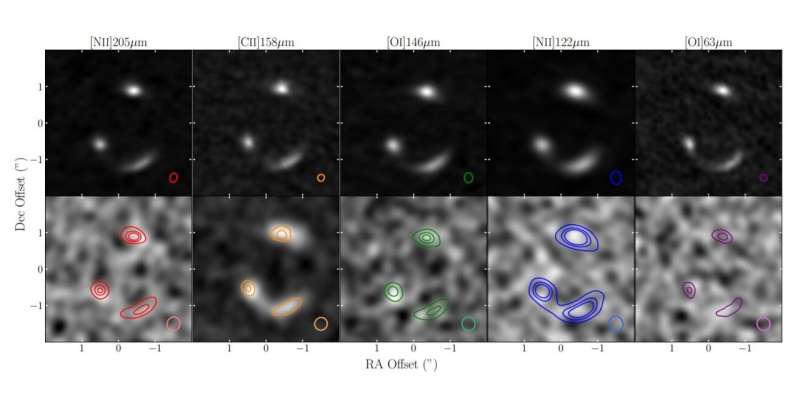Observed emission from SPT0346-52. Credit: Litke et al., 2022.
Using the Atacama Large Millimeter/submillimeter Array (ALMA), an international team of astronomers observed an interstellar medium in a distant star-forming galaxy SPT0346-52. The collected data could be essential in improving our knowledge about SPT0346-52 and other similar star-forming systems. The study was published February 25 on the arXiv pre-print repository.
Interstellar medium (ISM) is the matter and radiation that exist in the space between the star systems in a galaxy. However, ISM in distant galaxies is difficult to study directly due to cosmological dimming and angular resolution limitations.
So a group of researchers led by Katrina C. Litke of Steward Observatory in Tucson, Arizona, employed ALMA to investigate ISM in the high-redshift galaxy SPT0346-52. ALMA is an excellent tool for such observations as it enables new opportunities to explore the physical conditions in early galaxies through their rest-frame far-infrared emission.
SPTS J034640-5204.9 (or SPT0346-52 for short) is a gravitationally lensed dusty star-forming galaxy (DSFG) at a redshift of approximately 5.66. It has an apparent luminosity in far-infrared at a level of 110 trillion solar luminosities and an intrinsic star formation rate density of about 4,200 solar masses/year/kpc2, what makes it the most intensely star-forming galaxy detected by the South Pole Telescope survey.
Litke's team decided to conduct a multi-phase study of the ISM in SPT0346-52 with ALMA. So far, it is one of the first multi-line, spatially resolved studies of the ISM at high redshift.
"In this work we present ALMA Bands 6, 7 and 9 observations of [NII]205µm, [CII]158µm, [OI]146µm, and undetected [NII]122µm and [OI]63µm, as well as the underlying continuum at all five wavelengths, in the z = 5.7 lensed dusty star-forming galaxy SPT0346-52," the astronomers wrote in the paper.
The study found that the ISM in SPT0346-52 has lower ionization parameter and hydrogen density than other high-redshift DSFGs. It turns out that the ISM in this galaxy has a supersolar metallicity, similar to what would be expected from the gas to dust ratio in SPT0346-52.
Furthermore, the dust temperature of ISM in SPT0346-52 was measured to be 48.3 K, what is lower than the value obtained by previous studies. It was noted that the ionized gas was found to be less dense than gas of ISMs in comparable galaxies.
The researchers also managed to calculate ionized, neutral, and molecular gas masses of the studied ISM using a variety of methods. It appears that the molecular gas mass is about 100 times greater than the ionized gas mass and approximately four times larger than the neutral atomic gas mass. The authors of the paper concluded that the molecular ISM dominates the mass of SPT0346-52 and fuels the intense star-formation in this galaxy.
More information: Multi-Phase ISM in the z = 5.7 Hyperluminous Starburst SPT0346-52, arXiv:2202.12470 [astro-ph.GA] arxiv.org/abs/2202.12470
© 2022 Science X Network
























